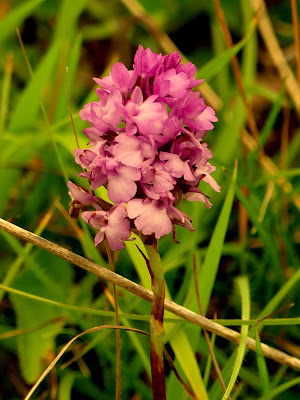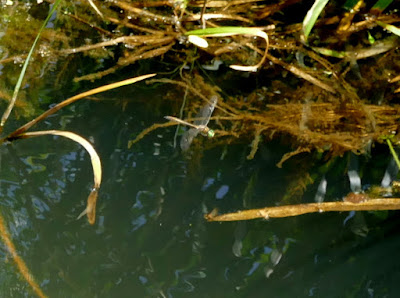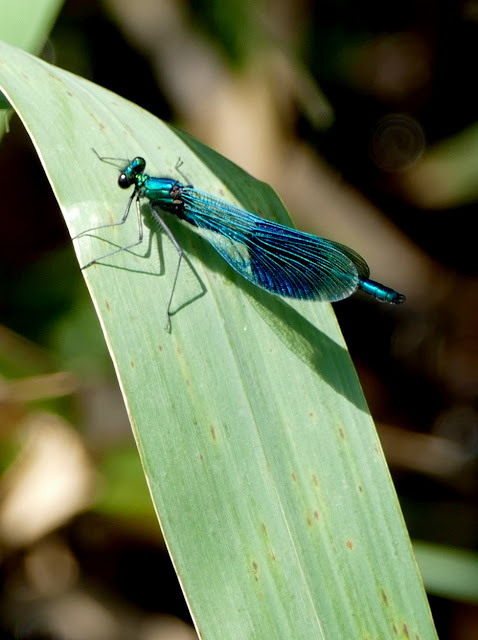This Ichneumon wasp, Protichneumon pisorius was feeding among an orgy of Hogweed bonking beetles, yesterday in Friston Forest, East Sussex.
It lays its eggs inside Hawkmoth caterpillars. The Ichneumon larva eats the Hawkmoth caterpillar alive, which eventually pupates and out comes the Ichneumon; source Insects of Britain and Western Europe by Michael Chinery.
My aspiration for yesterday was to find and photograph Broad-leaved Helleborines, which I failed to find. Any suggestions for locations will be most welcomed.
Seeing this insect was some compensation.
Another serendipitous photo' of a stripy insect (that I have yet to identify) was a tiny insect (enlarged below) -- another Ichneumon with a very long ovipositor for boring into rotting wood to find host caterpillars for its eggs.
For illustrated talks on natural history and history see www.peterlovetttalks.co.uk
For illustrated talks on natural history and history click here for www.peterlovetttalks.co.uk
Sunday, 26 July 2015
Thursday, 23 July 2015
Butterflies of Ashdown Forest; Large skipper on Wood sage, Teucrium scorodonia, Small skippers and Gatekeepers.
Butterflies yesterday on Ashdown Forest included scores of Large skippers, Ochlodes venatus, above on Wood sage, Teucrium scorodonia.
This is a plant that is not found on very calcareous soils and is one of the pleasures of walking on Ashdown Forest in contrast to the South Downs.
And above a Small skipper with a Gatekeeper.
Skippers were abundant on this day.
Friday, 17 July 2015
Pyramidal Orchids flowering on the South Downs of Sussex.
These graceful little Orchids are in full flower now.
Look out for variations in their petal form
Above the lobes are almost fused.
This variety, with unlobed lips is Anacamptis pyramidalis var. emarginata
Look out for variations in their petal form
Above the lobes are almost fused.
The combination of the orchid with Common Restharrow is wonderful to admire.
Thursday, 16 July 2015
The "Pride of Sussex" -- the County flower of Sussex, blooming now on the South Downs. And Pyramidal Orchids are at their prime as well.
Hot, cloudy, breezy and humid conditions yesterday gave good light for photography but the wind was problematic. Somehow or other I managed to spend three hours taking hundreds of pictures of butterflies, grasshoppers & crickets and flowers.
A hazy view to Chanctonbury Hill with the occasional solitary raindrop hitting me from time to time. There was no sustained rain though. Too bad!
It is lovely to see the Round-headed Rampion, the "Pride of Sussex" flowering again.
Above with a Six-spot Burnet moth.A hazy view to Chanctonbury Hill with the occasional solitary raindrop hitting me from time to time. There was no sustained rain though. Too bad!
Pyramidal Orchids were in peak condition, below being a nectar source for a Marbled White butterfly.
The profusion of seeded Yellow Rattle and numerous other flowering plants is spectacular at the moment.
Listen and look carefully and you will also see Grasshoppers and Crickets.
Tiny Hover-fly laying eggs on sunflower
This tiny Hover-fly caught my eye as it was so small and unknown to me.
I can find nothing like it in my books, so any suggestions as to what it is are very welcomed.
Here it is on a "Queen of Denmark" rose.
Help please!
I can find nothing like it in my books, so any suggestions as to what it is are very welcomed.
Its behavior sugested that it was laying eggs. The sunflowers are crawling with aphids giving plenty for the hover-fly larvae to graze on.
Here it is on a "Queen of Denmark" rose.
Help please!
Tuesday, 14 July 2015
The amazing mating wheel of the Common Blue Damselfly; captured crisply with a Panasonic DMC-FZ1000 zoom lens.
Click on the above picture to see if you can spot the pair of Common Blue Damselflies, Enallagma cyathigerum, center picture. Remaining on the same vantage point, the zoom lens of the spectacular Panasonic DMC-FZ1000 captured the images below.

The tandem position where the male has grabbed the female by the neck.

From the tandem position, the female curled her abdomen round to engage with the male in the heart-shaped mating circle.
An amazing sight -- observed thanks to an amazing camera.Sunday, 12 July 2015
Male Downy Emerald Dragonfly at Wakehurst Place, West Sussex
A visit was made to Wakehurst Place to get a ticket to visit the Loder valley yesterday, specifically to see Dragonflies and Damselflies. From the walkway in the wetlands area of Wakehurst Place a dragonfly was flying up and down. Taking pictures of such a fast-flying insect is pot luck for me. One hopes that one or two images might show something almost in focus.
My initial identification was incorrect and this has now been confirmed by Adrian at the British Dragonfly Society as a Male Downy Emerald Dragonfly, Cordulia aenea. Click here for more info' on the Downy Emerald. Thanks Adrian.
Click on any picture to expand it.
According to the "Field Guide to the Draonflies & Danselflies of Great Britain and Ireland" by Steve Brooks and Steve Cham, the Male Downy Emerald Dragonfly larvae live for two to three years on the bottom of sheltered woodland ponds, lakes and canals, feeding in coarse leaf litter close to the water margin. This is exactly the habitat here.
Click here for more info' on the British Dragonfly Society and these amazing insects.
And click here for details of the National Trust's Wakehurst Place.
My initial identification was incorrect and this has now been confirmed by Adrian at the British Dragonfly Society as a Male Downy Emerald Dragonfly, Cordulia aenea. Click here for more info' on the Downy Emerald. Thanks Adrian.
Click on any picture to expand it.
According to the "Field Guide to the Draonflies & Danselflies of Great Britain and Ireland" by Steve Brooks and Steve Cham, the Male Downy Emerald Dragonfly larvae live for two to three years on the bottom of sheltered woodland ponds, lakes and canals, feeding in coarse leaf litter close to the water margin. This is exactly the habitat here.
Click here for more info' on the British Dragonfly Society and these amazing insects.
And click here for details of the National Trust's Wakehurst Place.
My illustrated nature talks now include a module on Damselflies and Dragonflies. For more info' on my talks please click here
Friday, 10 July 2015
Banded Demoiselle, Calopteryx splendens by a stream south of Stopham Bridge, West Sussex, UK
This fast-flowing clear stream was home to numerous Banded Demoiselles, Calopteryx splendens yesterday.
Above, the male Banded Demoiselle, Calopteryx splendens.
And the female Banded Demoiselle, Calopteryx splendens above on a nettle leaf.
Dragonflies and Damselflies are one of many topics of my illustrated talks on natural history. Click on any picture to expand them.
For booking details, please see www.peterlovetttalks.co.uk for a public speaker with years of experience in illustrated and annotated presentations
Above, the male Banded Demoiselle, Calopteryx splendens.
And the female Banded Demoiselle, Calopteryx splendens above on a nettle leaf.
Dragonflies and Damselflies are one of many topics of my illustrated talks on natural history. Click on any picture to expand them.
For booking details, please see www.peterlovetttalks.co.uk for a public speaker with years of experience in illustrated and annotated presentations
Subscribe to:
Comments (Atom)
Blog Archive
-
▼
2015
(86)
-
▼
July
(10)
- Ichneumon wasp, Protichneumon pisorius among an or...
- Butterflies of Ashdown Forest; Large skipper on Wo...
- Pyramidal Orchids flowering on the South Downs of ...
- The "Pride of Sussex" -- the County flower of Suss...
- Tiny Hover-fly laying eggs on sunflower
- The amazing mating wheel of the Common Blue Damsel...
- Male Downy Emerald Dragonfly at Wakehurst Place, W...
- Banded Demoiselle, Calopteryx splendens by a strea...
- Seven Dragonfly and Damselfly species counted on W...
- Tree Damsel bug, Himacerus apterus in a chemical-f...
-
▼
July
(10)

















































